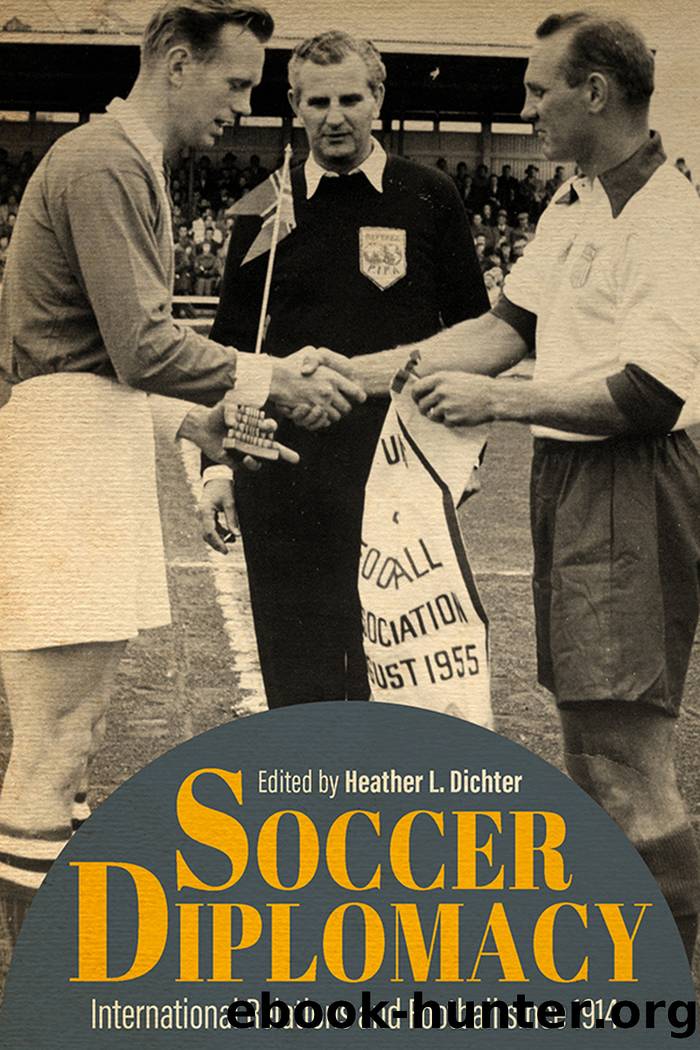Soccer Diplomacy by Heather L. Dichter;

Author:Heather L. Dichter;
Language: eng
Format: epub
Publisher: University Press of Kentucky
Published: 2020-04-15T00:00:00+00:00
Sheilas, Wogs, and Poofters in a War Zone
The âSocceroosâ and the 1967 Friendly Nations Tournament in Vietnam
Erik Nielsen
Until January 31, 2015, the Australian menâs national soccer team had won only one major international trophy. That nightâs extra-time victory against South Korea in the Asian Cup final supplemented another victory against that country under altogether different circumstances. The 1967 National Day Tournament was won in Saigon during a bloody war, amid great hardship for the team. The aftermath of the tour provoked a tension between the (admittedly partial) archival record and team captain Johnny Warrenâs belief that the Australian Federal government had sent the team as part of a propaganda offensive. An examination of this tension tells much about the perceived role that sport has played in Australiaâs diplomatic approach and about the extent to which this perception is supported by the historical record. The inconsistencies that such an examination reveals illuminate the cultural forces that mediate the popular understanding of these diplomatic efforts. This chapter will show that the most important cultural forces that mediated the popular understanding of Australiaâs involvement in Vietnam in general are particularly relevant to how the diplomatic importance of the 1967 Australian soccer tour to Vietnam is perceived.
Engagement with East Asia was a key plank of Australiaâs diplomatic approach in the years following the Second World War. While the White Australia policy continued to restrict Asian immigration in particular to Australia, the policy of âForward Defenceâ saw Australia militarily and politically project into the Asian theater. Australian military personnel played a key role in the occupation of Japan and participated in the Malayan Emergency. Between 1955 and 1988, the Royal Australian Air Force maintained a base at Butterworth on the Malay Peninsula, complete with the Australian families of servicemen being housed in the nearby town of Penang. Australia also contributed to the Colombo Plan, which saw students from across Asia study at Australian universities. Like military action in Southeast Asia, which included participation in the Vietnam War, the Colombo Plan aimed to prevent the spread of communism in the region.1
While the Asian region was an increasingly important focus of Australian diplomacy, the role that sport played in the nationâs diplomatic efforts remains unclear. Public servants working on the Colombo Plan expressed sporadic interest in using sport to further the programâs goals, although it is unclear whether the idea gained purchase with decision makers. The 1967 Australian soccer tour to Vietnam highlights the difficulties in assessing the role of sport in Australiaâs diplomatic efforts. The job of historians is made difficult by the National Archives of Australiaâs opaque approach to allowing access to records. As a result, engagement with unusual sources and debates is necessary to understand and assess the impact of Australian sport diplomacy on Australian and international political culture. The way that the shifting American approaches to memorializing Vietnam have shaped Australian responses to the same conflict is key to understanding Warrenâs belief that decisions made by the Australian government placed the team at significant and unjustified risk.
Download
This site does not store any files on its server. We only index and link to content provided by other sites. Please contact the content providers to delete copyright contents if any and email us, we'll remove relevant links or contents immediately.
| Arms Control | Diplomacy |
| Security | Trades & Tariffs |
| Treaties | African |
| Asian | Australian & Oceanian |
| Canadian | Caribbean & Latin American |
| European | Middle Eastern |
| Russian & Former Soviet Union |
The Secret History by Donna Tartt(18169)
The Social Justice Warrior Handbook by Lisa De Pasquale(11956)
Thirteen Reasons Why by Jay Asher(8458)
This Is How You Lose Her by Junot Diaz(6443)
Weapons of Math Destruction by Cathy O'Neil(5837)
Zero to One by Peter Thiel(5495)
Beartown by Fredrik Backman(5366)
The Myth of the Strong Leader by Archie Brown(5241)
The Fire Next Time by James Baldwin(5022)
How Democracies Die by Steven Levitsky & Daniel Ziblatt(4965)
Promise Me, Dad by Joe Biden(4909)
Stone's Rules by Roger Stone(4865)
100 Deadly Skills by Clint Emerson(4694)
A Higher Loyalty: Truth, Lies, and Leadership by James Comey(4554)
Rise and Kill First by Ronen Bergman(4547)
Secrecy World by Jake Bernstein(4390)
The David Icke Guide to the Global Conspiracy (and how to end it) by David Icke(4384)
The Farm by Tom Rob Smith(4328)
The Doomsday Machine by Daniel Ellsberg(4248)
